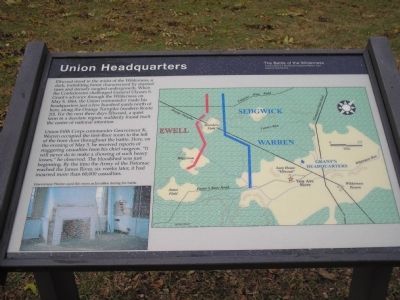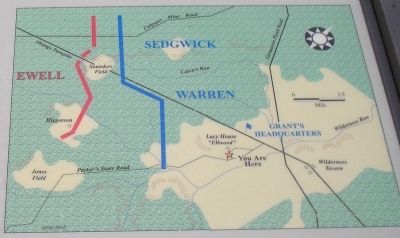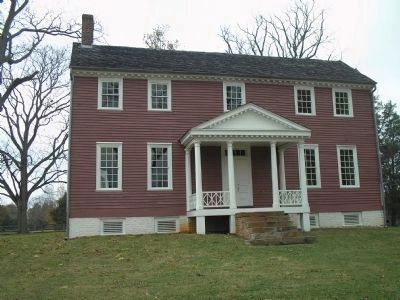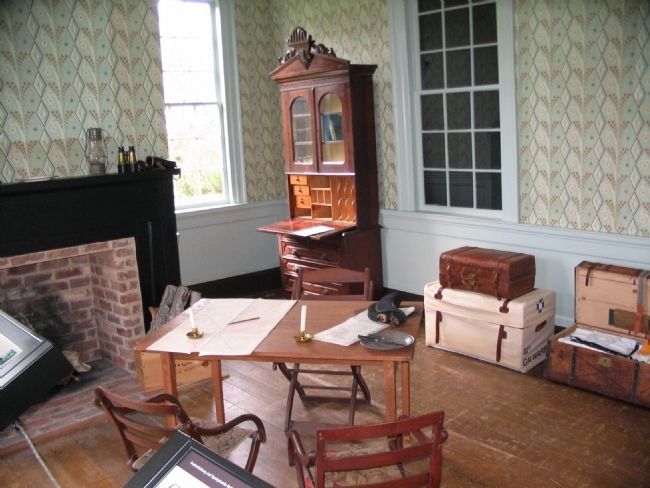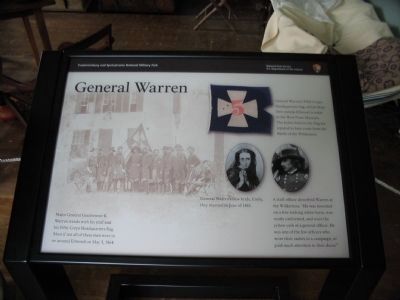Near Locust Grove in Orange County, Virginia — The American South (Mid-Atlantic)
Union Headquarters
The Battle of the Wilderness
— Fredericksburg and Spotsylvania National Military Park —
Union Fifth Corps commander Gouverneur K. Warren occupied the first-floor to the left of the front door throughout the battle. Here, on the evening of May 5, he received reports of staggering casualties from his chief surgeon. “It will never do to make a showing of such heavy losses,” he observed. The bloodshed was just beginning. By the time the Army of the Potomac reached the James River, six weeks later, it had incurred more than 60,000 casualties.
Erected by National Park Service, U.S. Department of the Interior.
Topics. This historical marker is listed in this topic list: War, US Civil. A significant historical month for this entry is May 1870.
Location. This marker has been replaced by another marker nearby. 38° 19.147′ N, 77° 43.884′ W. Marker is near Locust Grove, Virginia, in Orange County. Marker can be reached from Constitution Highway (Virginia Route 20), on the left when traveling west. Located at the Ellwood (Lacy House) section of the Wilderness Battlefield, within the Fredericksburg-Spotsylvania National Military Park. Touch for map. Marker is in this post office area: Locust Grove VA 22508, United States of America. Touch for directions.
Other nearby markers. At least 8 other markers are within walking distance of this location. A different marker also named Union Headquarters (here, next to this marker); A Military Scene (here, next to this marker); a different marker also named A Military Scene (here, next to this marker); Ellwood (within shouting distance of this marker); Archeology at Ellwood (within shouting distance of this marker); A Busy Place (within shouting distance of this marker); The Yard: A Busy Place (within shouting distance of this marker); Toil Without Choice at Ellwood (about 300 feet away, measured in a direct line). Touch for a list and map of all markers in Locust Grove.
More about this marker. The lower left of the marker has a modern day photograph of the interior of Ellwood with the caption Gouverneur Warren used this room as his office during the battle. The right half of the marker contains a map of troop positions during the Battle of the Wilderness.
This marker was replaced by a new one also named "Union Headquarters"
(see nearby markers).
Also see . . .
1. Ellwood Manor. (Submitted on March 11, 2008, by Bill Coughlin of Woodland Park, New Jersey.)
2. Battle of the Wilderness. (Submitted on March 11, 2008, by Bill Coughlin of Woodland Park, New Jersey.)
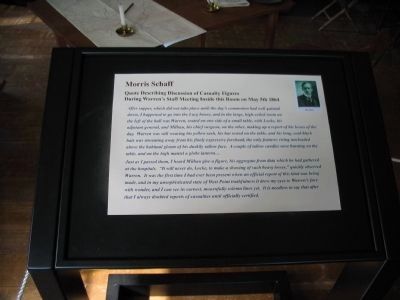
Photographed By Craig Swain, October 18, 2008
7. Morris Schaff
Quote describing the discussion of casualty figures during Warren's staff meeting inside this room on May 5th 1864.
After supper, which did not take place until the day's commotion had well quited down, I happened to go into the Lacy house, and in the large, high-ceiled room on the left of the hall was Warren, seated on one side of a small table, with Locke, his adjutant general, and Milhau, his chief surgeon, on the other, making up a report of his losses of the day. Warren was still wearing his yellow sash, his hat rested on the table, and his long, coal-black hair was streaming away from his finely expressive forehead, the only features rising unclouded above the habitual gloom of his duskily sallow face. A couple of tallow candles were buring on the table, and on the high mantel a globe lantern...
Just as I passed them, I heard Milhau give a figure, his aggregate from data which he had gathered from the hospitals. "It will never do, Locke, to make a showing of such heavy losses," quickly observed Warren. It was the first time I had ever been present when an official report of this kind was being made, and in my unsophisticated state of West Point truthfulness it drew my eyes to Warren's face with wonder, and I can see its earnest, mournfully solemn lines yet. It is needless to say that after that I always doubted reports of casualties until officially certified.
After supper, which did not take place until the day's commotion had well quited down, I happened to go into the Lacy house, and in the large, high-ceiled room on the left of the hall was Warren, seated on one side of a small table, with Locke, his adjutant general, and Milhau, his chief surgeon, on the other, making up a report of his losses of the day. Warren was still wearing his yellow sash, his hat rested on the table, and his long, coal-black hair was streaming away from his finely expressive forehead, the only features rising unclouded above the habitual gloom of his duskily sallow face. A couple of tallow candles were buring on the table, and on the high mantel a globe lantern...
Just as I passed them, I heard Milhau give a figure, his aggregate from data which he had gathered from the hospitals. "It will never do, Locke, to make a showing of such heavy losses," quickly observed Warren. It was the first time I had ever been present when an official report of this kind was being made, and in my unsophisticated state of West Point truthfulness it drew my eyes to Warren's face with wonder, and I can see its earnest, mournfully solemn lines yet. It is needless to say that after that I always doubted reports of casualties until officially certified.
Credits. This page was last revised on August 21, 2021. It was originally submitted on March 11, 2008. This page has been viewed 1,676 times since then and 19 times this year. Last updated on September 5, 2020, by Bradley Owen of Morgantown, West Virginia. Photos: 1, 2, 3. submitted on March 11, 2008, by Bill Coughlin of Woodland Park, New Jersey. 4. submitted on March 15, 2008, by Bill Coughlin of Woodland Park, New Jersey. 5, 6, 7. submitted on October 24, 2008, by Craig Swain of Leesburg, Virginia. • J. Makali Bruton was the editor who published this page.
